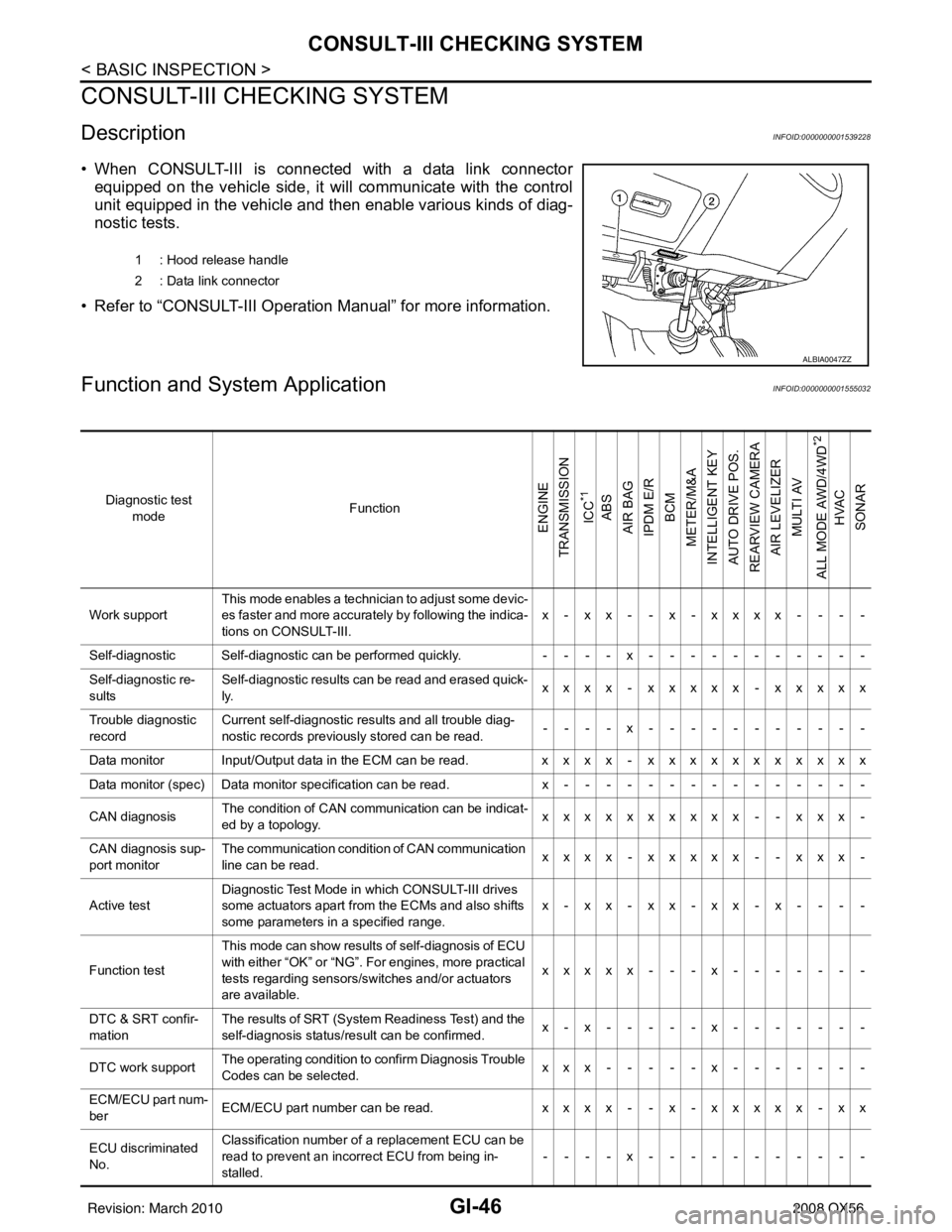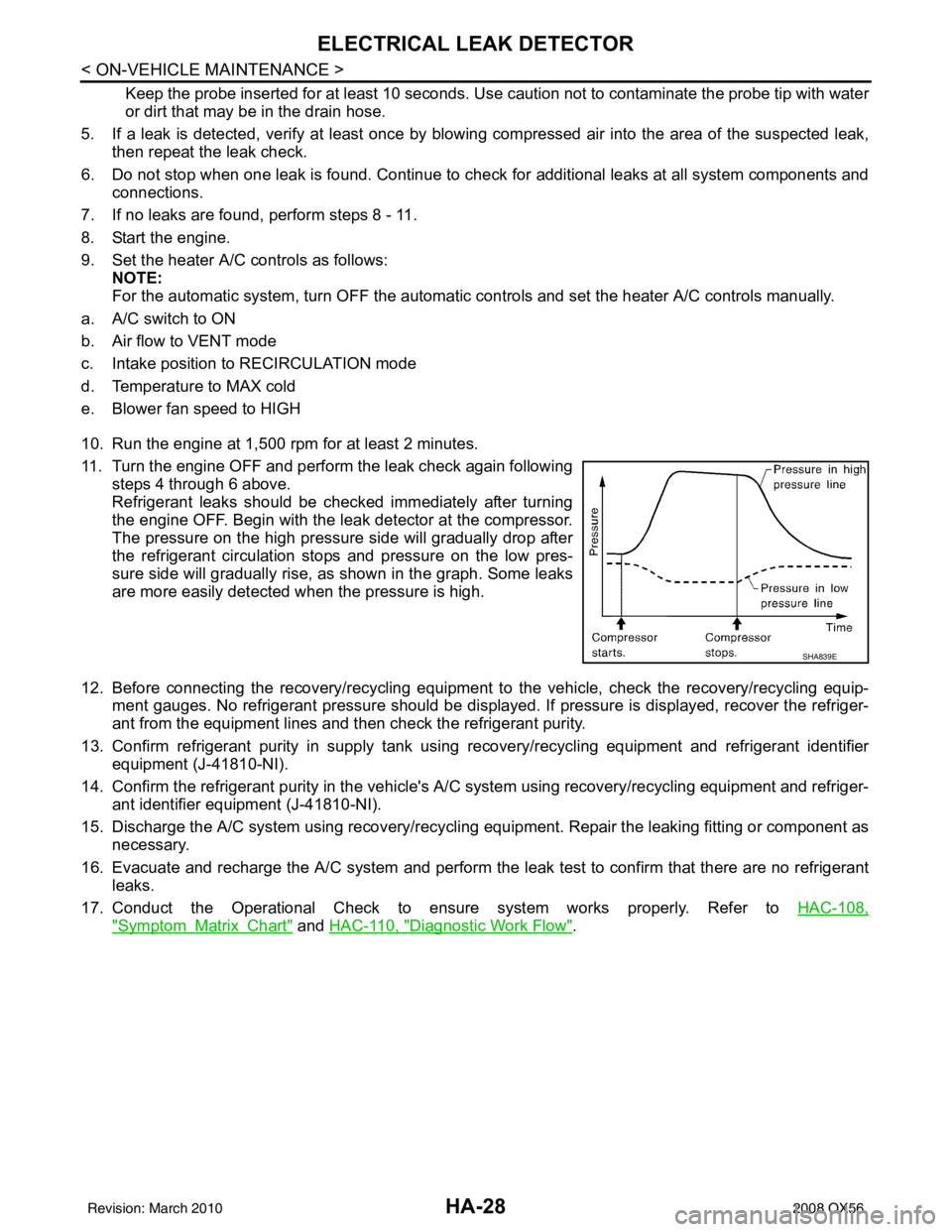2008 INFINITI QX56 ECO mode
[x] Cancel search: ECO modePage 2188 of 4083

GI-46
< BASIC INSPECTION >
CONSULT-III CHECKING SYSTEM
CONSULT-III CHECKING SYSTEM
DescriptionINFOID:0000000001539228
• When CONSULT-III is connected with a data link connectorequipped on the vehicle side, it will communicate with the control
unit equipped in the vehicle and then enable various kinds of diag-
nostic tests.
• Refer to “CONSULT-III Operation Manual” for more information.
Function and System ApplicationINFOID:0000000001555032
1 : Hood release handle
2 : Data link connector
ALBIA0047ZZ
Diagnostic test mode Function
ENGINE
TRANSMISSION
ICC
*1
ABS
AIR BAG
IPDM E/R
BCM
METER/M&A
INTELLIGENT KEY
AUTO DRIVE POS.
REARVIEW CAMERA
AIR LEVELIZER MULTI AV
ALL MODE AWD/4WD
*2
HVAC
SONAR
Work support This mode enables a technician to adjust some devic-
es faster and more accurately by following the indica-
tions on CONSULT-III. x - xx - - x - xxxx - - - -
Self-diagnostic Self-diagnostic can be performed quickly. ----x-----------
Self-diagnostic re-
sults Self-diagnostic results can be read and erased quick-
ly.
xxxx - xxxxx - xxxxx
Trouble diagnostic
record Current self-diagnostic results and all trouble diag-
nostic records previously stored can be read.
--- - x--- - -------
Data monitor Input/Output data in the ECM can be read. xxxx - xxxxxxxxxxx
Data monitor (spec)Data monitor specification can be read. x---------------
CAN diagnosis The condition of CAN communication can be indicat-
ed by a topology.
xxxxxxxxxx - - xxx -
CAN diagnosis sup-
port monitor The communication condition of CAN communication
line can be read.
xxxx - xxxxx - - xxx -
Active test Diagnostic Test Mode in which CONSULT-III drives
some actuators apart from the ECMs and also shifts
some parameters in a specified range. x-xx-xx-xx-x- - - -
Function test This mode can show results of self-diagnosis of ECU
with either “OK” or “NG”. For engines, more practical
tests regarding sensors/switches and/or actuators
are available. xxxxx - - - x
-------
DTC & SRT confir-
mation The results of SRT (System Readiness Test) and the
self-diagnosis status/result can be confirmed.
x-x-----x-------
DTC work support The operating condition to confirm Diagnosis Trouble
Codes can be selected. xxx-----x-------
ECM/ECU part num-
ber ECM/ECU part number can be read.
xxxx - - x - xxxxx - xx
ECU discriminated
No. Classification number of a replacement ECU can be
read to prevent an incorrect ECU from being in-
stalled.
----x-----------
Revision: March 2010
2008 QX56
Page 2192 of 4083

GW-2
< PRECAUTION >
PRECAUTIONS
PRECAUTION
PRECAUTIONS
Precaution for Supplemental Restraint System (SRS) "AIR BAG" and "SEAT BELT
PRE-TENSIONER"
INFOID:0000000004884108
The Supplemental Restraint System such as “A IR BAG” and “SEAT BELT PRE-TENSIONER”, used along
with a front seat belt, helps to reduce the risk or severity of injury to the driver and front passenger for certain
types of collision. This system includes seat belt switch inputs and dual stage front air bag modules. The SRS
system uses the seat belt switches to determine the front air bag deployment, and may only deploy one front
air bag, depending on the severity of a collision and w hether the front occupants are belted or unbelted.
Information necessary to service the system safely is included in the SR and SB section of this Service Man-
ual.
WARNING:
• To avoid rendering the SRS inopera tive, which could increase the risk of personal injury or death in
the event of a collision which would result in air bag inflation, all maintenance must be performed by
an authorized NISSAN/INFINITI dealer.
• Improper maintenance, including in correct removal and installation of the SRS, can lead to personal
injury caused by unintent ional activation of the system. For re moval of Spiral Cable and Air Bag
Module, see the SR section.
• Do not use electrical test equipmen t on any circuit related to the SRS unless instructed to in this
Service Manual. SRS wiring harn esses can be identified by yellow and/or orange harnesses or har-
ness connectors.
PRECAUTIONS WHEN USING POWER TOOLS (AIR OR ELECTRIC) AND HAMMERS
WARNING:
• When working near the Airbag Diagnosis Sensor Unit or other Airbag System sensors with the Igni-
tion ON or engine running, DO NOT use air or electri c power tools or strike near the sensor(s) with a
hammer. Heavy vibration could activate the sensor( s) and deploy the air bag(s), possibly causing
serious injury.
• When using air or electric power tools or hammers , always switch the Ignition OFF, disconnect the
battery, and wait at least 3 minu tes before performing any service.
Precaution Necessary for Steering W heel Rotation After Battery Disconnect
INFOID:0000000004881261
NOTE:
• This Procedure is applied only to models with Intelligent Key system and NATS (NISSAN ANTI-THEFT SYS-
TEM).
• Remove and install all control units after disconnecting both battery cables with the ignition knob in the
″LOCK ″ position.
• Always use CONSULT-III to perform self-diagnosis as a part of each function inspection after finishing work.
If DTC is detected, perform trouble diagnosis according to self-diagnostic results.
For models equipped with the Intelligent Key system and NATS, an electrically controlled steering lock mech-
anism is adopted on the key cylinder.
For this reason, if the battery is disconnected or if the battery is discharged, the steering wheel will lock and
steering wheel rotation will become impossible.
If steering wheel rotation is required when battery pow er is interrupted, follow the procedure below before
starting the repair operation.
OPERATION PROCEDURE
1. Connect both battery cables. NOTE:
Supply power using jumper cables if battery is discharged.
2. Use the Intelligent Key or mechanical key to turn the ignition switch to the ″ACC ″ position. At this time, the
steering lock will be released.
3. Disconnect both battery cables. The steering lock will remain released and the steering wheel can be rotated.
4. Perform the necessary repair operation.
Revision: March 2010 2008 QX56
Page 2208 of 4083

PRECAUTIONSHA-3
< PRECAUTION >
C
DE
F
G H
J
K L
M A
B
HA
N
O P
PRECAUTION
PRECAUTIONS
Precaution for Supplemental Restraint System (SRS) "AIR BAG" and "SEAT BELT
PRE-TENSIONER"
INFOID:0000000004884163
The Supplemental Restraint System such as “AIR BAG” and “SEAT BELT PRE-TENSIONER”, used along
with a front seat belt, helps to reduce the risk or severi ty of injury to the driver and front passenger for certain
types of collision. This system includes seat belt switch inputs and dual stage front air bag modules. The SRS
system uses the seat belt switches to determine the front air bag deployment, and may only deploy one front
air bag, depending on the severity of a collision and w hether the front occupants are belted or unbelted.
Information necessary to service the system safely is included in the SR and SB section of this Service Man-
ual.
WARNING:
• To avoid rendering the SRS inoper ative, which could increase the risk of personal injury or death in
the event of a collision which would result in air bag inflation, all maintenance must be performed by
an authorized NISSAN/INFINITI dealer.
• Improper maintenance, including in correct removal and installation of the SRS, can lead to personal
injury caused by unintentional act ivation of the system. For removal of Spiral Cable and Air Bag
Module, see the SR section.
• Do not use electrical test equipm ent on any circuit related to the SRS unless instructed to in this
Service Manual. SRS wiring harnesses can be identi fied by yellow and/or orange harnesses or har-
ness connectors.
PRECAUTIONS WHEN USING POWER TOOLS (AIR OR ELECTRIC) AND HAMMERS
WARNING:
• When working near the Airbag Diagnosis Sensor Un it or other Airbag System sensors with the Igni-
tion ON or engine running, DO NOT use air or el ectric power tools or strike near the sensor(s) with a
hammer. Heavy vibration could activate the sensor( s) and deploy the air bag(s), possibly causing
serious injury.
• When using air or electric power tools or hammers, always switch the Ignition OFF, disconnect the battery, and wait at least 3 minutes before performing any service.
Precaution Necessary for Steering Wheel Rotation After Battery Disconnect
INFOID:0000000004884164
NOTE:
• This Procedure is applied only to models with Intelligent Key system and NATS (NISSAN ANTI-THEFT SYS-
TEM).
• Remove and install all control units after disconnecti ng both battery cables with the ignition knob in the
″ LOCK ″ position.
• Always use CONSULT-III to perform self-diagnosis as a part of each function inspection after finishing work.
If DTC is detected, perform trouble diagnosis according to self-diagnostic results.
For models equipped with the Intelligent Key system and NATS , an electrically controlled steering lock mech-
anism is adopted on the key cylinder.
For this reason, if the battery is disconnected or if the battery is discharged, the steering wheel will lock and
steering wheel rotation will become impossible.
If steering wheel rotation is required when battery power is interrupted, follow the procedure below before
starting the repair operation.
OPERATION PROCEDURE
1. Connect both battery cables. NOTE:
Supply power using jumper cables if battery is discharged.
2. Use the Intelligent Key or mechanical key to turn the ignition switch to the ″ACC ″ position. At this time, the
steering lock will be released.
3. Disconnect both battery cables. The steering lock will remain released and the steering wheel can be
rotated.
4. Perform the necessary repair operation.
Revision: March 2010 2008 QX56
Page 2233 of 4083

HA-28
< ON-VEHICLE MAINTENANCE >
ELECTRICAL LEAK DETECTOR
Keep the probe inserted for at least 10 seconds. Use caution not to contaminate the probe tip with water
or dirt that may be in the drain hose.
5. If a leak is detected, verify at least once by blowing compressed air into the area of the suspected leak, then repeat the leak check.
6. Do not stop when one leak is found. Continue to check for additional leaks at all system components and connections.
7. If no leaks are found, perform steps 8 - 11.
8. Start the engine.
9. Set the heater A/C controls as follows: NOTE:
For the automatic system, turn OF F the automatic controls and set the heater A/C controls manually.
a. A/C switch to ON
b. Air flow to VENT mode
c. Intake position to RECIRCULATION mode
d. Temperature to MAX cold
e. Blower fan speed to HIGH
10. Run the engine at 1,500 rpm for at least 2 minutes.
11. Turn the engine OFF and perform the leak check again following steps 4 through 6 above.
Refrigerant leaks should be checked immediately after turning
the engine OFF. Begin with the leak detector at the compressor.
The pressure on the high pressure side will gradually drop after
the refrigerant circulation stops and pressure on the low pres-
sure side will gradually rise, as shown in the graph. Some leaks
are more easily detected when the pressure is high.
12. Before connecting the recovery/recycling equipment to the vehicle, check the recovery/recycling equip-
ment gauges. No refrigerant pressure should be displayed. If pressure is displayed, recover the refriger-
ant from the equipment lines and t hen check the refrigerant purity.
13. Confirm refrigerant purity in supply tank using recovery/recycling equipment and refrigerant identifier
equipment (J-41810-NI).
14. Confirm the refrigerant purity in the vehicle's A/C system using recovery/recycling equipment and refriger-
ant identifier equipment (J-41810-NI).
15. Discharge the A/C system using recovery/recycling equipment. Repair the leaking fitting or component as
necessary.
16. Evacuate and recharge the A/C system and perform the leak test to confirm th\
at there are no refrigerant leaks.
17. Conduct the Operational Check to ensure system works properly. Refer to HAC-108,
"SymptomMatrixChart" and HAC-110, "Diagnostic Work Flow".
SHA839E
Revision: March 2010 2008 QX56
Page 2276 of 4083
![INFINITI QX56 2008 Factory Service Manual SELF-DIAGNOSIS FUNCTIONHAC-23
< FUNCTION DIAGNOSIS > [AUTOMATIC AIR CONDITIONER]
C
D
E
F
G H
J
K L
M A
B
HAC
N
O P
• Press the “BACK” switch and the “UP” switch within 10 seconds after turni INFINITI QX56 2008 Factory Service Manual SELF-DIAGNOSIS FUNCTIONHAC-23
< FUNCTION DIAGNOSIS > [AUTOMATIC AIR CONDITIONER]
C
D
E
F
G H
J
K L
M A
B
HAC
N
O P
• Press the “BACK” switch and the “UP” switch within 10 seconds after turni](/manual-img/42/57030/w960_57030-2275.png)
SELF-DIAGNOSIS FUNCTIONHAC-23
< FUNCTION DIAGNOSIS > [AUTOMATIC AIR CONDITIONER]
C
D
E
F
G H
J
K L
M A
B
HAC
N
O P
• Press the “BACK” switch and the “UP” switch within 10 seconds after turning the ignition switch from OFF to ACC and hold them for
3 seconds or more. Then the buzzer sounds, all indicators of the
preset switch illuminate, and the self-diagnosis mode starts.
• The continuity of each switch and control dials (A/C and AV switch assembly only) at the ON position can be checked by pressing
each switch and turning each control dial. The buzzer sounds and
LED’s will illuminate if the switch is normal.
Finishing self-diagnosis mode
Self-diagnosis mode is canceled when turning the ignition switch OFF.
A/C System Self-Diagnosis Code ChartINFOID:0000000001679781
SELF-DIAGNOSTIC CODE CHART
AWIIA0171GB
Code No. Reference page
03 Battery voltage out of range CHG-11, "
Inspection Procedure"
30 In-vehicle sensor circuit out of range (low)
HAC-81, "In-Vehicle Sensor Diagnosis Procedure"31 In-vehicle sensor circuit out of range (high)
40 Ambient sensor circuit shortHAC-78, "
Ambient Sensor Diagnosis Procedure"41 Ambient sensor circuit open
50 Optical sensor (Driver) circuit open or shortHAC-84, "
Optical Sensor Diagnosis Procedure"52 Optical sensor (Passenger) circuit open or short
56 Intake sensor circuit shortHAC-86, "
Intake Sensor Diagnosis Procedure"57 Intake sensor circuit open
80 CAN bus faultLAN-14, "
Trouble Diagnosis Flow Chart"
Revision: March 2010 2008 QX56
Page 2280 of 4083
![INFINITI QX56 2008 Factory Service Manual MODE DOOR MOTORHAC-27
< COMPONENT DIAGNOSIS > [AUTOMATIC AIR CONDITIONER]
C
D
E
F
G H
J
K L
M A
B
HAC
N
O P
NO >> Repair or replace harness as necessary.
3.CHECK A/C AUTO AMP. FOR GROUND AND POWER
1. INFINITI QX56 2008 Factory Service Manual MODE DOOR MOTORHAC-27
< COMPONENT DIAGNOSIS > [AUTOMATIC AIR CONDITIONER]
C
D
E
F
G H
J
K L
M A
B
HAC
N
O P
NO >> Repair or replace harness as necessary.
3.CHECK A/C AUTO AMP. FOR GROUND AND POWER
1.](/manual-img/42/57030/w960_57030-2279.png)
MODE DOOR MOTORHAC-27
< COMPONENT DIAGNOSIS > [AUTOMATIC AIR CONDITIONER]
C
D
E
F
G H
J
K L
M A
B
HAC
N
O P
NO >> Repair or replace harness as necessary.
3.CHECK A/C AUTO AMP. FOR GROUND AND POWER
1. Press the mode switch to the D/F ( ) mode.
2. Check voltage between A/C auto amp. harness connector M49 terminal 19 and terminal 20 while pressing the mode switch to
the vent ( ) mode.
Is the inspection result normal?
YES >> GO TO 4.
NO >> Replace A/C auto amp. Refer to VTL-7, "
Removal and Installation".
4.CHECK MODE DOOR MOTOR AND CIRCUITS FOR OPEN
1. Turn ignition switch OFF.
2. Disconnect the A/C auto amp. harness connector.
3. Check continuity between A/C auto amp. harness connector M49 terminal 19 and terminal 20.
Is the inspection result normal?
YES >> GO TO 6.
NO >> GO TO 5.
5.CHECK MODE DOOR MOTOR CIRCUITS FOR OPEN
1. Disconnect the mode door motor harness connector.
2. Check continuity between A/C auto amp. harness connector M49 (A) terminal 19, 20 and the mode door motor harness con-
nector M142 (B) terminal 5, 6.
Is the inspection result normal?
YES >> Replace mode door motor. Refer to VTL-24, "Removal
and Installation".
NO >> Repair or replace harness as necessary.
6.CHECK A/C AUTO AMP. FOR PBR POWER AND GROUND
1. Reconnect A/C auto amp. harness connector.
2. Turn ignition switch ON.
3. Check voltage between A/C auto amp. harness connector M50 (A) terminal 28 and M49 (B) terminal 3.
Is the inspection result normal?
YES >> GO TO 8.
NO >> GO TO 7.
Connector Te r m i n a l s
Condition Voltage
(Approx.)
(+) (-)
A/C auto amp.: M49 19 20 Press
mode
switch Battery
voltage
AWIIA0097ZZ
Continuity should exist.
AWIIA0098ZZ
5 - 19 : Continuity should exist.
6 - 20 : Continuity should exist.
AWIIA0094ZZ
Connector Te r m i n a l s
Voltage (Ap-
prox.)
(+) (-)
A/C auto amp.: M49, M50 28 35V
AWIIA0099ZZ
Revision: March 2010 2008 QX56
Page 2281 of 4083
![INFINITI QX56 2008 Factory Service Manual HAC-28
< COMPONENT DIAGNOSIS >[AUTOMATIC AIR CONDITIONER]
MODE DOOR MOTOR
7.CHECK PBR REFERENCE VOLTAGE
CIRCUIT FOR SHORT TO GROUND
1. Turn ignition switch OFF.
2. Disconnect the A/C auto amp. harnes INFINITI QX56 2008 Factory Service Manual HAC-28
< COMPONENT DIAGNOSIS >[AUTOMATIC AIR CONDITIONER]
MODE DOOR MOTOR
7.CHECK PBR REFERENCE VOLTAGE
CIRCUIT FOR SHORT TO GROUND
1. Turn ignition switch OFF.
2. Disconnect the A/C auto amp. harnes](/manual-img/42/57030/w960_57030-2280.png)
HAC-28
< COMPONENT DIAGNOSIS >[AUTOMATIC AIR CONDITIONER]
MODE DOOR MOTOR
7.CHECK PBR REFERENCE VOLTAGE
CIRCUIT FOR SHORT TO GROUND
1. Turn ignition switch OFF.
2. Disconnect the A/C auto amp. harness connector.
3. Check continuity between A/C auto amp. harness connector M50 terminal 28 and ground.
Is the inspection result normal?
YES >> Replace A/C auto amp. Refer to VTL-7, "Removal and
Installation".
NO >> Repair or replace harness as necessary.
8.CHECK PBR REFERENCE VOLTAGE AND GROUND CIRCUITS
1. Turn ignition switch OFF.
2. Disconnect the A/C auto amp. harness connector.
3. Check continuity between A/C auto amp. harness connector M50 (A) terminal 28 and M49 (B) terminal 3.
Is the inspection result normal?
YES >> GO TO 10.
NO >> GO TO 9
9.CHECK PBR REFERENCE VO LTAGE CIRCUIT FOR OPEN
1. Disconnect the mode door motor harness connector.
2. Check continuity between mode door motor harness connector M142 (B) terminal 3, 1 and A/C auto amp. harness connector
M49 (C) terminal 3, M50 (A) terminal 28.
Is the inspection result normal?
YES >> Replace mode door motor. Refer to VTL-24, "Removal
and Installation".
NO >> Repair or replace harness as necessary.
10.CHECK PBR FEEDBACK VOLTAGE
1. Reconnect the A/C auto amp. harness connector.
2. Turn ignition switch ON.
3. Check voltage between A/C auto amp. harness connector M49 terminal 7 and ground while cycling mode switch through all
modes.
Is the inspection result normal?
YES >> GO TO 12.
NO >> GO TO 11.
11 .CHECK PBR FEEDBACK SIGNAL CIRCUIT FOR SHORT TO GROUND Continuity should not exist.
AWIIA0100ZZ
Continuity should exist.
AWIIA0101ZZ
28 - 1
: Continuity should exist.
3 - 3 : Continuity should exist.
AWIIA0102ZZ
Voltage : Approx. 1V - 4.5V
AWIIA0103ZZ
Revision: March 2010 2008 QX56
Page 2302 of 4083
![INFINITI QX56 2008 Factory Service Manual BLOWER MOTOR CONTROL SYSTEMHAC-49
< COMPONENT DIAGNOSIS > [AUTOMATIC AIR CONDITIONER]
C
D
E
F
G H
J
K L
M A
B
HAC
N
O P
BLOWER MOTOR CONTROL SYSTEM
System DescriptionINFOID:0000000001679795
SYSTEM DES INFINITI QX56 2008 Factory Service Manual BLOWER MOTOR CONTROL SYSTEMHAC-49
< COMPONENT DIAGNOSIS > [AUTOMATIC AIR CONDITIONER]
C
D
E
F
G H
J
K L
M A
B
HAC
N
O P
BLOWER MOTOR CONTROL SYSTEM
System DescriptionINFOID:0000000001679795
SYSTEM DES](/manual-img/42/57030/w960_57030-2301.png)
BLOWER MOTOR CONTROL SYSTEMHAC-49
< COMPONENT DIAGNOSIS > [AUTOMATIC AIR CONDITIONER]
C
D
E
F
G H
J
K L
M A
B
HAC
N
O P
BLOWER MOTOR CONTROL SYSTEM
System DescriptionINFOID:0000000001679795
SYSTEM DESCRIPTION
Component Parts
Blower speed control system components are:• A/C auto amp.
• A/C and AV switch assembly
• Variable blower control
• Front blower motor relay
• Front blower motor
• In-vehicle sensor
• Ambient sensor
• Optical sensor
• Intake sensor
System Operation
Automatic Mode
In the automatic mode, the blower motor speed is calc ulated by the A/C auto amp. and variable blower control
based on input from the in-vehicle sensor, optical sens or, intake sensor and ambient sensor, and potentio tem-
perature control (PTC).
When the air flow is increased, the blower motor s peed is adjusted gradually to prevent a sudden increase in
air flow.
In addition to manual air flow control and the usual automat ic air flow control, starting air flow control, low
water temperature starting control and high passenger compartment temperature starting control are avail-
able.
Starting Blower Speed Control
Start up from cold soak condition (Automatic mode).
In a cold start up condition where the engine coolant temperature is below 50 °C (122° F), the blower will not
operate at blower speed 1 for a short period of time ( up to 210 seconds). The exact start delay time varies
depending on the ambient and engine coolant temperatures.
In the most extreme case (very low ambient temper ature) the blower starting delay will be 210 seconds as
described above. After the coolant temperature reaches 50 °C (122 °F), or the 210 seconds has elapsed, the
blower speed will increase to the objective blower speed.
Start up from usual operating or hot soak condition (Automatic mode).
The blower will begin operation momentarily after the AUTO switch is pushed. The blower speed will gradually
rise to the objective speed over a time period of 3 seconds or less (actual time depends on the objective
blower speed).
AWIIA0173GB
Revision: March 2010 2008 QX56